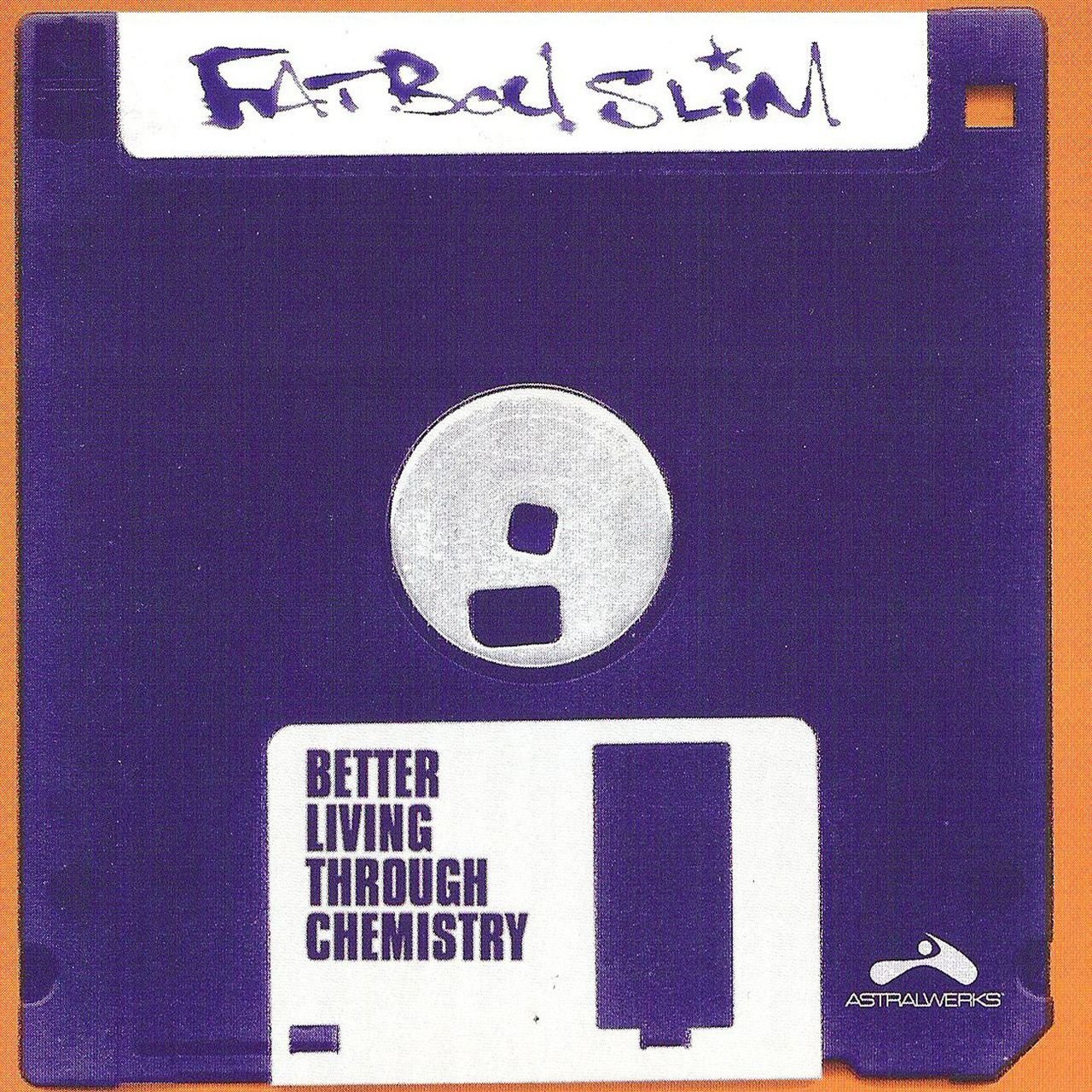多くの音楽ジャンルは、特定の社会運動やイベントと切り離せない形で結びついています。それらは、創造主の思考、希望、夢に対する継続的なコメントを提供するだけでなく、楽しむためのものでもあります。しかし、他にもそのような重要性の重みから解放されて存在するカテゴリーがあり、音楽そのものの喜びのための音楽です。ビッグビートは明らかに後者のカテゴリーに含まれますが、振り返ってみれば、これを弱点ではなく強みと考えることができるかもしれません。この異質なアーティストの広がりは、他のどこにも確実に分類できない素材を指すカッチオール用語となったため、簡単には分類できませんでした。その中心には、しっかりとした120〜140 bpmのテンポと、通常はローランドのTB-303による重いシンセライン、そしてありとあらゆるところから来たサンプルがありました。これらは、特定のビッグビートではない素材でも、ちょうどその場所と時間にうまく機能するものが簡単に特集されたセットに組み合わされました。
いくつかのジャンルと同様に、特にダンスミュージックにおいて、ビッグビートの意味のある生命は短いですが、その中で活動していたアーティストたちが次に行った場所に関しては間違いなく影響力がありました。また、ビッグビートトラックの映画やテレビでの継続的な使用に関しても、興味深く耐久性があることが証明されています。ジャンルに馴染みがない場合でも、すでにその一部を聞いたことがあるかもしれません。おそらく、一番重要なのは、数えきれない12インチシングルに加えて、何年も経っても良い聴きごたえを持つ素晴らしいアルバムの山を残したことです。

ファットボーイ・スリム: より良い生活のための化学
ノーマン・クックは、ルイジアナのギャングの名前を採用する前に、すでに多忙な音楽キャリアを持っていました。そして、彼はビッグビートシーンから最も認識されるアーティストの一人になりました。多くの人は、続編の長い道のりを歩んできた君へをより良いアルバムとして指摘するでしょう。確かに、こちらの方が知られていますが、彼の最初の作品は、ビッグビートの美学により合致しています。クックのプロデューサーとしての活動や、一般的に多忙なスケジュールのおかげで、このアルバムの一部のトラックは1996年のリリース日よりも最大で3年前に録音されましたが、全体として非常によくまとまっています。後のファットボーイ・スリムのアルバムよりもサンプル駆動が少ないより良い生活のための化学は、ジャンルの基本—パーカッションとベースラインをリードし、ほぼ「残りの楽器を補完する」形で構成されています。しかし、音楽的な素晴らしさを伴う瞬間もあります。遅いペースでほぼリラックスした雰囲気の「ウィークエンドが始まる」は、かなり洗練されたトラックで、かなり控えめな材料のさりげない組み合わせから生まれています。

ローフィデリティ・オールスターズ 爆発した心で操作する方法
1998年にデビューアルバムがリリースされた時、ローフィデリティ・オールスターズはイングランド北部の5人の音楽家からなるグループで、U.K.南海岸のスタジオ「ブレインファーム」で活動し、ビッグビートシーンに最も関連の深いレコードレーベル、スキント・レコーズに署名していました。彼らが作り出したアルバムは間違いなくビッグビートジャンルの一部ですが、全体としてはポジティブな見方の音楽の中で、オールスターズはよりダークで思慮深いサウンドを持っていました。ただし、アルバムにはダンスしやすい曲も含まれており、とりわけ「バトルフラッグ」は、シアトルのバンドPigeonhedの同名トラックの根本的なリミックスであり、未ミックスの親トラックよりもずっと知られるようになりました。これらのトラックを集約したのは、グループ独自の歌詞スタイルとサンプルの巧妙な使用から得られた、ほぼトリップホップ風の遅い曲の選択でした。

ベントレー・リズム・エース ベントレー・リズム・エース
バーミンガムを拠点にするベントレー・リズム・エースは、元Pop Will Eat Itselfのレギュラーであるリチャード・マーチとバグウィード・センチペードのマイク・ストークスで構成されています。PWEIのドラマー、ファズ・タウンゼンドとキース・ヨークが定期的にサポートし、彼らの同名のデビューアルバムはビッグビートジャンルのクラシックであり、当時の他のアーティストとは異なります。サウンドの重要な要素は、英国の子供向けテレビ番組からの思いがけない数のサンプルを幅広く使用し、1960年代と70年代のファンクやソウルの録音から大きく影響を受けた、よりクリーンでベース主導でない音楽スタイルで組み合わされました。そしてこのアルバムは、これまでにリリースされたものとは本当に異なり、この結果としては彼らにとって普遍的な挑戦となりました。簡単な補足ですが、このリストにあるほぼすべてのアーティストは優れたDJでも音楽家であり、マーチとストークスのデュオはこのようにパフォーマンスする際に見逃せない存在でした。彼らのセットにはカー・ブート・セールの発見を織り交ぜて、非常に楽しませるセットを作り出していました。

ミッドフィールド・ジェネラル 一般化
ダミアン・ハリスは、もし彼が自身のマテリアルをリリースしたことがなかったとしても、ビッグビートにおいて非常に重要だと見なされたでしょう。スキントレコーズの創設者であり、彼はこのリストにある多くのアーティストの署名に責任があり、同時にDJとしてもかなりの名声を得ていました。ミッドフィールド・ジェネラルという名前でいくつかのシングルをリリースした後、2000年にデビューアルバムを発表しました。ノーマン・クックの親しい友人であったため、アルバムの多くの側面が同じ時期のファットボーイ・スリムの作品と似ているのは驚くことではないでしょうが、一般化にはまた異なるアナーキーな一面があります。これが、無邪気なコメディアン、ノエル・フィールディングによるモノローグが特徴で、イギリスの哺乳動物の軍隊を連れていく男性の壮大な物語を描いている「ミッドフィールド」トラックに素晴らしく象徴されています。「トロイのシュルー」をカバーしたキットカットのラッパで覆われたキャラクターの話です。それが狂っていると感じられるなら、あなたはほとんど理解するところに来ています。

プロペラヘッズ デックスアンドドラムスアンドロックアンドロール
プロデューサーのウィル・ホワイトとアレックス・ギフォード(後者はストラングラーズのサックス奏者でもあります)は、1995年にプロペラヘッズを結成し、彼らの名前は50年代のアメリカのオタクを指す用語から取られています。彼らの唯一のアルバムは、このリストにある他の多くのアルバムと同様、アルバムがリリースされる数年前から存在していた素材を盛り込んでいました。しかし、素材がこれほど素晴らしいものであれば、あまり関係ありません。バンドの特徴的なサウンドの鍵は、通常のビッグビートに典型的なより洗練されたパーカッションと、彼らの同時代のほとんどのアーティストよりも一歩上のフックで構成されています。これは、「女王陛下の秘密兵器」のテーマの素晴らしい再編(「あなたも二度生きる」にインタールードが含まれています)や、ファビュラスにファンキーな「歴史は繰り返す」に最も顕著です。後者は、ビッグビートトラックとしては比較的一般的であるが特に書かれたボーカルと、シャーリー・バッシーが歌ったボーカル曲を特徴としていました。健康上の理由からデュオとしてのさらなる活動はできませんでしたが、このアルバムのトラックは、現在も映画やテレビで使われ続けており、印象的なレガシーを残しています。

ライオンロック 探偵の直感
DJでプロデューサーのジャスティン・ロバートソンは、1980年代後半からU.K.ダンスミュージックで活動しており、リミックスやプロデュースの成功を多数収めた後、M.CバズBとシンセサイザー奏者のロジャー・ライオンズと共にライオンロックを設立しました。ロバートソンはほぼすべてのジャンルのダンス音楽をプレイしており(決してダンス音楽として作られることのなかったものをも)、探偵の直感がビッグビートとトリップホップの交差点に立っていることは驚くべきことではありません。それは、通常の財務精度と印象的なボーカルから成るアルバムです。そしてその曲は「頭に直接」で「深さ」のようなものを具現化し、これにより、アルバムはあらゆる種類の楽しさを持つことができるのです。「火を上げる靴ののこぎり」のようなトラックが示すように、ラフなエッジのあるビッグビートのサウンドを十分に示しているのです。ロバートソンはまだDJとして活動を続けており、彼のレギュラーの場所の1つは最近ブログで紹介されたスピリットランドです。

インディアン・ロープマン エレファント・サウンド
ビッグビートは主に白人アーティストのものとされていましたが、その音楽の幅を広げる興味深い追加の一つはブライトン出身のサンジ・センから来ました。インディアン・ロープマンとして、彼は60年代のジュリー・ダリスコールの曲から名前を借りて、ビッグビートの基本を取り入れ、インド亜大陸からの独特の影響を交えました。彼の唯一のアルバムエレファント・サウンドでは、これらの影響が控えめではありますが効果的に使用されており、アルバムに独特の音を与えつつまったく別のものにはなっていません。このことは、「66メートル」というトラックで特に優雅に示されており、クラシックなTB-303ベースラインや缶入りパーカッションと、シタールの素敵なフレーズを絶妙に組み合わせ、シャヒン・バダールが歌ったボーカルカットにサポートされています。もちろん、センは伝統的なビッグビートサウンドを提供することも完全に可能であり、「ピアノの犬」のようなしばしば楽しいデメントなトラックで完璧に示されています。

カット・ラ・ロック ラ・ロック・ロックス
ある意味では、カット・ラ・ロック(本名リー・ポッター)はDJとして知られることが常であり、同時に9台のデッキでパフォーマンスすることで、芸術の最も効果的な提唱者の一人となっています。しかし、カット・ラ・ロックとしては、ビッグビートサウンドに別の次元を加え、ラ・ロック・ロックスで簡単に見分けられます。アシッドハウスとジャングルの背景を持ち、このアルバムは異なるビッグビートサウンドの端を跨るもので、重なり合う音が複雑なドラムとベーススタイルのドラムラインとほぼヒップホップの風味と時折衝突します。必須のビッグビートでの愉快さは、ヒップホップ・ビビディ・バップ・バップの形で提供されて、完全に異なるジャンル間の「防火帯」として頻繁にライブセットに入り込みました。このアルバムは11曲の中で非常に多くの地面をカバーし、約1時間未満がかかり、スノーパトロールのゲストボーカル、ギャリー・ライトボディが素晴らしい存在を存分に発揮しています。彼は1999年にアルバムが録音されたときにはほとんど知られていませんでした。

ミント・ロイヤル ダンスホール・プレイス
ミント・ロイヤルの2枚目のアルバムが2002年にリリースされた時、ビッグビートの栄光の日々が過ぎ去ったと議論することは完璧に可能でしたが、それでもダンスホール・プレイスはそれを楽しむために基礎を取り、穏やかに進化させました。マンチェスター出身のデュオ、ニール・クラクストンとクリス・ベイカーは、評価の高いシングルを何本か製作し、ノーマン・クックのDJセットで特にお気に入りになりました。このアルバムでは、大部分のトラックのテンポとアレンジが元を大いにビッグビートで、知られたシングル「ジャマイカで最もセクシーな男」は、シンガーソングライターのプリンス・バスターのサンプリングを使用しており、ビッグビート以外の何物でも見られません。しかし、特にオープニングの「ブルー・ソング」やタイトル曲のように、進展する曲もあります。ビッグビートとして具体的に何が成り立つかの異なる性質によって、アクティブなアーティストは少数であり、その崩壊によって不完全な状況に追い込まれることはありませんでしたが、その進化を優雅に示したアルバムがそう多くはありませんでした。

イービル・ナイン あなたも特別になれます
あなたも特別になれますが2004年に登場した時には、ビッグビートが死んでいるという論争が完全に可能であり、まったく異なるジャンルに属していると考えられます。同様に、イービル・ナインを構成するデュオ、トム・ボーフォイとパトリック・パーディは、ビッグビートのピーク年間を通じて活動しており、あなたも特別になれますはそのジャンルの主要な魅力のいくつかを利用して、異なるよりダークなサウンドを形成しています。これはビッグベースライン、慎重に選ばれたサンプル、構造的パーカッションのアルバムですが、その成分を使って以前にあったものとは異なるサウンドを生み出しました。特に重要なのは、Aesop Rockやトースティ・テイラーからの素晴らしいゲストボーカルの使用です。アルバムがリリースされたとき、Marine Paradeレーベルは財政的困難に見舞われており、ノーマン・クックのDJセットでは非常に要求されたアルバムとなりました。残念ながら、これは今日においても同様で、ビニールリリースは非常に希少で、今もなお可視性がありません。
Ed is a UK based journalist and consultant in the HiFi industry. He has an unhealthy obsession with nineties electronica and is skilled at removing plastic toys from speakers.
